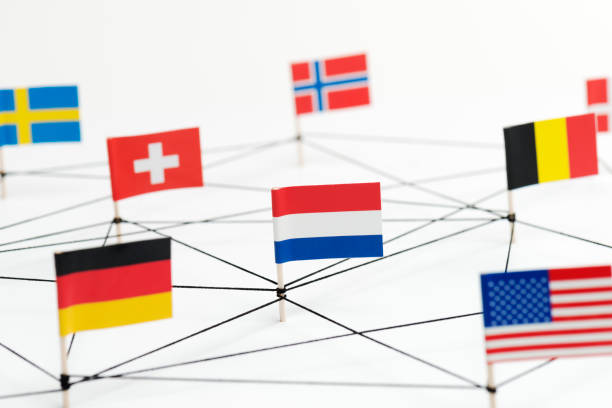Introduction
In an increasingly interconnected world, the role of intellectual property (IP) in shaping international trade relations cannot be overstated. Intellectual property rights, encompassing patents, trademarks, copyrights, and trade secrets, serve as the bedrock for innovation, fostering economic growth and competition. The interplay between IP and global trade is intricately woven into the fabric of international relations, and this blog aims to explore the multifaceted role of international IP agreements in influencing and regulating trade relations.

Understanding Intellectual Property
Before delving into the role of international agreements, it is imperative to grasp the concept of intellectual property. Intellectual property refers to intangible creations of the mind, including inventions, literary and artistic works, designs, symbols, names, and images used in commerce. These creations are protected by legal mechanisms such as patents, copyrights, trademarks, and trade secrets to incentivize innovation and creativity while providing creators with exclusive rights.
IP and Economic Growth
Intellectual property plays a pivotal role in fostering economic growth by encouraging innovation. Strong IP protection provides inventors, creators, and businesses with the confidence that their investments in research and development will be rewarded. This, in turn, promotes the creation of new technologies, products, and services, fueling economic progress and competitiveness on a global scale.
The Globalization of Trade and Intellectual Property
As trade barriers continue to diminish and the global economy becomes increasingly interconnected, the importance of intellectual property in international trade has grown significantly. Businesses now operate on a global scale, necessitating a harmonized approach to IP protection to facilitate cross-border transactions and collaborations.
International IP Agreements: A Framework for Cooperation
TRIPS Agreement
The Agreement on Trade-Related Aspects of Intellectual Property Rights (TRIPS) is a landmark international agreement administered by the World Trade Organization (WTO). Enforced since 1995, TRIPS establishes minimum standards for IP protection and enforcement, providing a framework for member countries to align their national IP laws with global norms. TRIPS represents a significant step in integrating intellectual property into the multilateral trading system, emphasizing the link between innovation, trade, and economic development.
Paris Convention for the Protection of Industrial Property
The Paris Convention, established in 1883, predates TRIPS and focuses on the protection of industrial property, including patents, trademarks, and industrial designs. This convention facilitates the international filing of patent applications and ensures that creators and inventors enjoy priority rights across member countries. By promoting a standardized approach to IP protection, the Paris Convention contributes to the development of a global IP infrastructure that supports international trade.
Berne Convention for the Protection of Literary and Artistic Works
Enacted in 1886, the Berne Convention addresses the protection of copyrights for literary and artistic works. It establishes the principle of automatic protection, meaning that the copyright of a work is granted automatically without the need for formalities. The Berne Convention sets forth minimum standards for copyright protection, fostering a conducive environment for the international exchange of creative works and contributing to the cultural and economic dimensions of global trade.
Madrid Agreement and Protocol Concerning the International Registration of Marks
The Madrid System provides a centralized mechanism for the international registration of trademarks. The agreement and protocol, administered by the World Intellectual Property Organization (WIPO), simplify the process of obtaining trademark protection in multiple jurisdictions. This streamlining of procedures enhances the efficiency of global trademark registration, promoting the expansion of businesses across borders and facilitating international trade.
Challenges and Controversies
While international IP agreements aim to create a harmonized and predictable environment for global trade, challenges and controversies persist.
Balancing National Interests
One of the ongoing challenges is striking a balance between the interests of developed and developing nations. Developing countries often seek flexibility in implementing IP standards to address their unique economic and social needs. Striking a delicate balance between promoting innovation and allowing for technology transfer and access to essential goods and services remains a key challenge.
Enforcement Disparities
Enforcement of intellectual property rights varies across jurisdictions, leading to concerns about the effectiveness of global IP agreements. Disparities in legal systems, enforcement mechanisms, and the capacity of regulatory bodies can create challenges for businesses seeking to protect their intellectual assets in different parts of the world.
Emerging Technologies and Regulatory Gaps
The rapid pace of technological advancement has outpaced the development of international IP frameworks. Emerging technologies such as artificial intelligence, biotechnology, and blockchain present novel challenges that may not be adequately addressed by existing agreements. Bridging regulatory gaps to accommodate these innovations while ensuring adequate protection is an ongoing concern.

Future Prospects and Innovations
As the global landscape continues to evolve, so too must international intellectual property agreements. Several key areas warrant attention and innovation to address emerging challenges and foster an environment conducive to international trade:
Digital Economy and E-Commerce
The rise of the digital economy and e-commerce has transformed the way goods and services are traded globally. International IP agreements need to adapt to the challenges posed by digital piracy, online counterfeiting, and the protection of digital assets. Establishing robust mechanisms for the protection of digital intellectual property will be crucial in ensuring a fair and secure digital marketplace.
Green Technologies and Climate Innovation
With a growing focus on sustainability and climate change, intellectual property agreements must address the unique challenges posed by green technologies. Encouraging the dissemination of environmentally friendly innovations while protecting the intellectual property of inventors in this space is essential for promoting global sustainability and addressing pressing environmental issues.
Global Health and Access to Medicines
The COVID-19 pandemic highlighted the need for a balanced approach to intellectual property in the context of global health emergencies. Future international agreements should consider mechanisms to ensure timely access to essential medicines and vaccines while providing incentives for research and development in the pharmaceutical sector.
Conclusion
In conclusion, the role of international intellectual property agreements in shaping global trade relations is multifaceted and integral to the functioning of the modern global economy. These agreements provide a framework for harmonizing IP standards, fostering innovation, and facilitating cross-border trade. However, challenges persist, and ongoing efforts are required to address disparities, strike a balance between national interests, and adapt to the evolving landscape of technology and commerce.
Looking ahead, the future of international IP agreements lies in their ability to innovate and adapt to emerging challenges while upholding the principles of fairness, inclusivity, and sustainability. As nations collaborate to build a more interconnected and prosperous world, the role of intellectual property in shaping global trade relations will continue to be a critical factor in driving economic growth and fostering innovation on a global scale.

